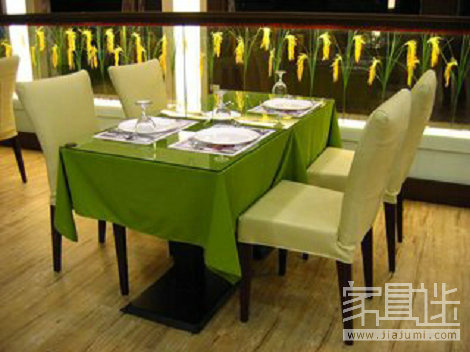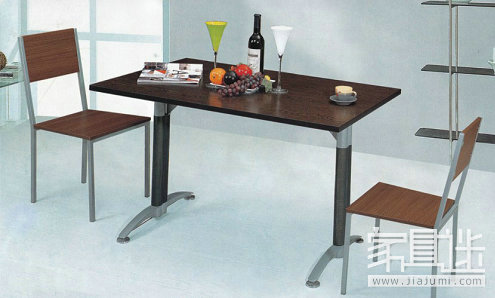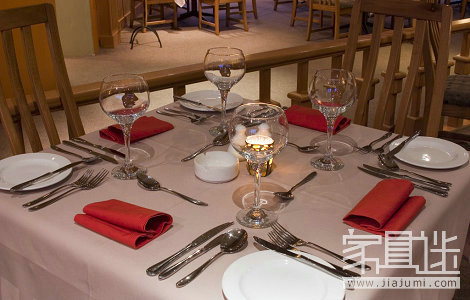Western cuisine, as the name suggests, refers to the traditional eating style from Western countries. With the growing popularity of Western food, having an appropriately designed Dining Table is essential. A Western-style dining table differs significantly from a Chinese-style one. It exudes a modern and elegant look, without the traditional Chinese aesthetic. This kind of table reflects contemporary fashion and sophistication.

**Classification of Western Dining Tables**
In Western culture, dining tables come in various shapes, including square and rectangular. Square tables are typically smaller and ideal for intimate dinners, such as romantic candlelit meals. Rectangular tables, on the other hand, can vary in size. Smaller ones are suitable for family gatherings, while larger ones are perfect for group events where people sit face-to-face, allowing for better interaction and conversation.
**Standard Dimensions of Restaurant Tables**
- **Dining Table Height**: 75–78 cm (standard), Western-style tables are usually 68–72 cm.
- **Square Table Widths**: 120 cm, 90 cm, 75 cm.
- **Rectangular Table Widths**: 80 cm, 90 cm, 105 cm, 120 cm; Lengths: 150 cm, 165 cm, 180 cm, 210 cm, 240 cm.
- **Round Table Diameters**: 90 cm, 120 cm, 135 cm, 150 cm, 180 cm.
**Table Sizes and Layouts**
1. **Table Height**: 750–790 mm
2. **Dining Chair Height**: 450–500 mm
3. **Round Table Diameter**:
- 2 people: 500 mm
- 2 people: 800 mm
- 4 people: 900 mm
- 5 people: 1100 mm
- 6 people: 1100–1250 mm
- 8 people: 1300 mm
- 10 people: 1500 mm
- 12 people: 1800 mm
4. **Square Table Size**:
- 2 people: 700 × 850 mm
- 4 people: 1350 × 850 mm
- 8 people: 2250 × 850 mm
5. **Table Turntable Diameter**: 700–800 mm
6. **Table Spacing**: Should be more than 500 mm between seats.

**Proper Arrangement of Tableware on a Western Dining Table**
1. Tableware should be placed on the right side of the guest, with each person having a space of 24 inches horizontally and 16 inches vertically.
2. The dining table should be centered in front of the guest's seat for convenience.
3. A knife is placed on the right side of the plate, with the blade facing inward.
4. A fork is placed on the outer side of the knife, with the tines upward.
5. Two forks are placed on the left side of the plate: the inner one is the salad fork, and the outer one is the dinner fork, both tines up.
6. One fork and one spoon may be placed on the upper front part of the plate. They can be placed before or at the same time as the main course.
7. The bread and butter dish is placed on the left front of the fork, with a butter knife parallel to the fork.
8. Beverage glasses are placed in the middle of the upper end of the knife.
9. Condiments and ashtrays are placed in the center of the table. On two-seat tables against the wall, they are placed near the wall.
**Etiquette for Eating Western Food**
Eating Western food involves a set of formal rules that differ from Chinese dining customs. The tableware is more complex, and the pace is generally slower. Understanding these etiquette rules helps avoid embarrassment.
Guests should sit on the left side of the chair and leave by the same side. It’s important to wait until the host spreads their napkin before doing so. The napkin should be placed on your lap. When leaving the table temporarily, never leave the napkin on the table, as it signals you’re done. Instead, place it on the chair.
In formal settings, the napkin is folded and placed on the lap, not fully spread or tucked into the waist. However, in casual meals, it’s more flexible. If you need to step away, always place the napkin on the chair, not on the table.
After finishing the meal, the napkin can be roughly folded and placed on the table. If you find something unsuitable in your glass or food, don’t shout. Instead, politely ask the waiter to replace it. Similarly, when changing dishes or utensils, do so discreetly.
When drinking, wipe your lips with a napkin before taking a sip to avoid stains. Avoid using paper napkins for this purpose. Don’t push plates aside or move them around. If you drop crumbs, just ignore them unless the waiter removes the plate, then carefully pick up any fallen food with a napkin.
Hold the knife in your right hand and the fork in your left. Use the fork to cut food and then bring it to your mouth with the same hand. When eating small snacks like biscuits or chips, you can eat them by hand. Bread should be torn with your right hand, and cream should be eaten with a knife, not big bites. Never eat soup with a spoon directly from the bowl.

**Maintenance of Western Dining Tables**
Most Western dining tables are made of marble, which is durable but requires proper care. Here are some maintenance tips:
1. Marble is prone to staining, so minimize water use when cleaning.
2. Always use warm water mixed with a mild detergent for cleaning to maintain the table's longevity.
3. For minor scratches, use a marble cleaner and gently wipe the area to restore its appearance.
By following these guidelines, you can ensure that your Western dining experience is both stylish and respectful. Whether you're hosting a dinner party or enjoying a meal at a restaurant, understanding the table sizes, arrangements, and etiquette will enhance your overall experience.
Dining Table
dining table
Foshan Jianermei Furniture Co., Ltd , https://www.minottiitaly.com